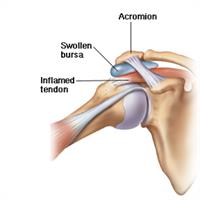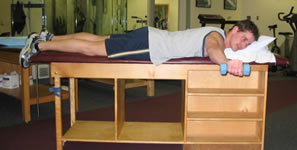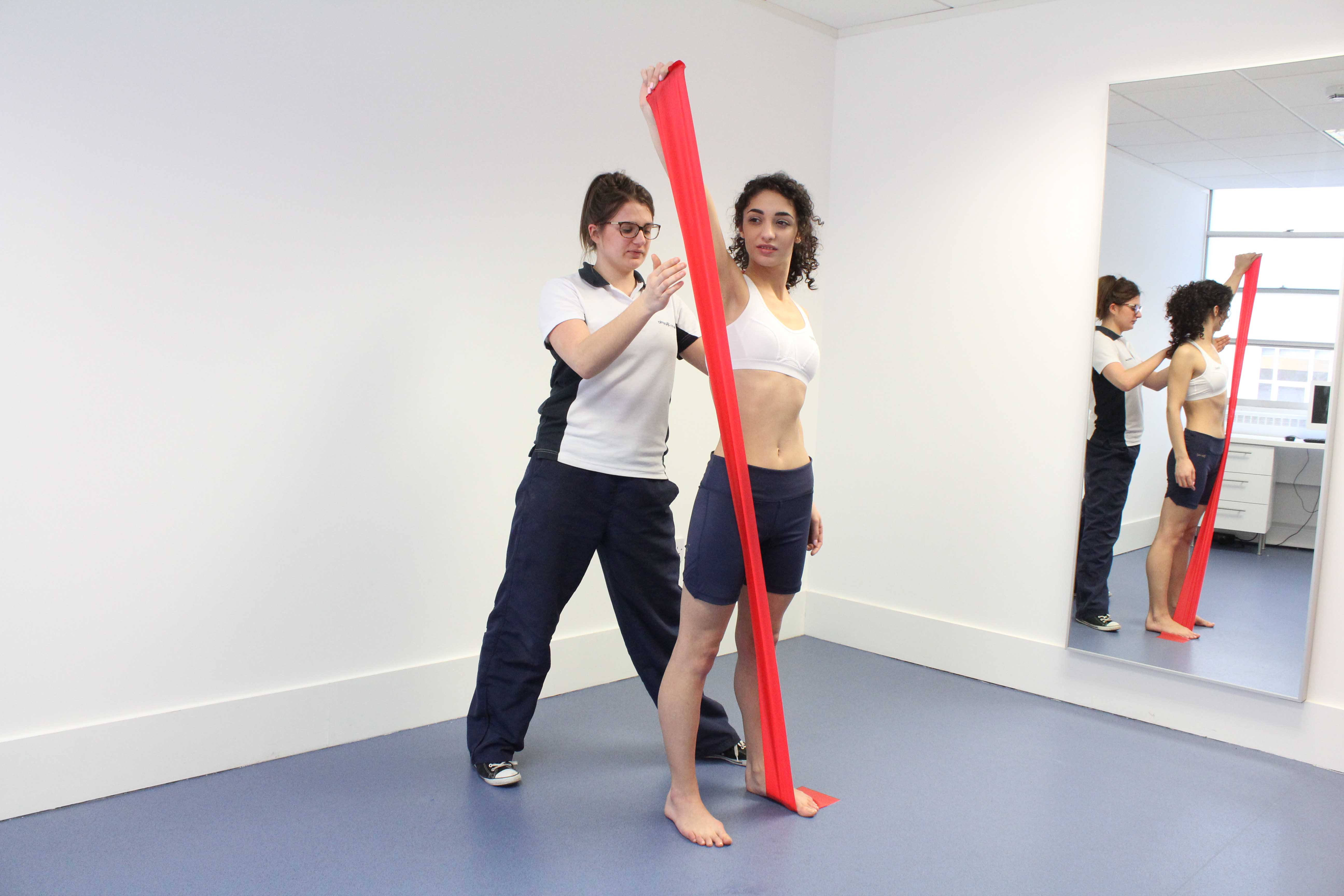|
BOOK NOW |
ASK ABOUT YOUR PAIN |
Home > Blog > Physiotherapy > Spine Pain > Shoulder Pain > Shoulder Bursitis Physiotherapy
Shoulder Bursitis Physiotherapy

Shoulder bursitis is a painful shoulder condition that affects people of all ages.
This shoulder condition tends to develop more in middle-aged, elderly, and individuals who have muscle weakness.
Shoulder bursitis can have many causes, but the most common is a repetitive activity, such as
- overhead reaching
- throwing
- or arm-twisting
which creates friction in the upper shoulder area.
Athletes often develop shoulder bursitis after
- throwing
- pitching
- or swimming repetitively
The condition can happen gradually or suddenly, or can be a result of an autoimmune disease.
But in some cases, it can also occur without any specific cause. Shoulder bursitis physiotherapy can be a very effective treatment for shoulder bursitis to
- reduce pain
- reduce swelling
- reduce stiffness
- and associated weakness in the shoulder, arm, neck, and upper back
Shoulder impingement and tendinitis can occur along with shoulder bursitis. A physical therapist can effectively treat all of these conditions together.
What is Shoulder Bursitis?

Shoulder bursitis (also called subacromial bursitis) happens when the shoulder bursa (a fluid-filled sac on the side of the shoulder) becomes
- damaged
- irritated
- or inflamed
Bursitis ("-itis"); means "inflammation") means the bursa has become irritated and inflamed, which causes pain.
Normally, the bursa acts as a cushion for the rotator cuff tendon of the supraspinatus muscle that sits under the bursa, and prevents the tendon from rubbing on the acromion bone above the bursa.
Certain positions, motions, or disease processes can cause additional and unnecessary friction or stress on the bursa, leading to the development of bursitis. When the bursa becomes injured, the tendon doesn't glide smoothly over it, and can become painful.
Shoulder bursitis can be caused by:
- Repetitive motions (overhead reaching or lifting, throwing, or twisting of the arm)
- Muscle weakness or poor muscle coordination
- Incorrect posture
- Direct trauma (being hit, or falling on, the side of the shoulder)
- Shoulder surgery or replacement
- Calcium deposits in the shoulder
- Overgrowth or bone spurs in the acromion bone
- Infection
- Autoimmune diseases, such as rheumatoid arthritis, gout, psoriasis, or thyroid disease
- Muscles or tendons in the shoulder area rubbing the bursa and causing irritation
How Does shoulder bursitis Feel like?
With shoulder bursitis, you may experience:
- Pain on the outer side or tip of the shoulder
- Pain when you push with your finger on the tip of the shoulder
- Pain when lying on the affected shoulder
- Pain that worsens when lifting the arm to the side
- Pain when rotating the arm
- Pain when pushing or pulling open a door
How Is It Diagnosed?
If you see our senior physiotherapists first, we will conduct a thorough evaluation that includes taking your health history. We also will ask you detailed questions about your injury, such as:
- How and when did you notice the pain?
- Have you been performing any repetitive activity?
- Did you receive a direct hit to the shoulder, or had a fall on it?
We also will perform special tests to help determine the likelihood that you have shoulder bursitis.
We will gently press on the outer side of the shoulder to see if it is painful to the touch, and may use additional tests to determine if other parts of your shoulder are injured. We also will observe your posture, and how you lift your arm.
We will test and screen for other, more serious conditions that could cause shoulder pain.
To provide a definitive diagnosis, we may collaborate with an orthopedic physician or other health care provider, who may order further tests, such as an X-ray to confirm the diagnosis and to rule out other damage to the shoulder, such as a fracture.
how our senior physiotherapists can help you

We will work with you to design a specific treatment program that will speed your recovery, including exercises and treatments that you can do at home. Physical therapy will help you return to your normal lifestyle and activities.
All patients will ask us how many sessions needed or how much times is needed....and the real answer is that the time it takes to heal the condition varies, but results can often be achieved in 4 to 8 weeks, when a proper physiotherapy stretching and strengthening program is implemented.
During the first 24 to 48 hours following your diagnosis, we may advise you to:
- Rest the area by avoiding lifting or reaching overhead, or any activity that causes pain.
- Apply cold therapy to the area for 15 to 20 minutes every 2 hours.
- Consult with a physician for further services, such as medication or diagnostic tests.
We will work with you to:
Reduce Pain and Swelling
If repetitive activities have caused the shoulder bursitis, we will help you understand how to avoid or modify the activities to allow healing to begin. We may use different types of treatments and technologies to control and reduce your pain and swelling, including
- cold therapy
- heat therapy
- ultrasound therapy
- radio-frequency Indiba physiotherapy
- electrical stimulation
- taping
- stretching exercises
- specific exercises
- hands on manual therapy
- dry needling
- deep tissue release
- etc
Improve Motion
We will choose specific activities and treatments to help restore normal movement in the shoulder and arm. These might begin with "passive" motions that we will do for you to gently move your shoulder joint, and progress to active exercises and stretches that you do yourself.
Improve Flexibility
We will determine if any shoulder, arm, chest, or neck muscles are tight, start helping you to stretch them, and teaching you how to stretch them.
Improve posture
If posture problems are found to be related to your condition, we will work with you to help improve your posture to help alleviate your pain, and prevent future recurrence.

Improve Strength
Shoulder bursitis is often related to weak, injured, or uncoordinated shoulder muscles. Certain exercises will aid healing at each stage of recovery; we will choose and teach you the correct exercises and equipment to use to steadily restore your strength and agility.
These may include using
- cuff weights
- stretch bands
- and weight lifting equipment
Improve Endurance
Regaining your muscular endurance in the shoulder is important after an injury. We will teach you exercises to improve your muscular endurance, so you can return to your normal activities.
Cardio-exercise equipment may be used, such as
- upper-body ergometers
- treadmills
- or stationary bicycles
Return to Activities
We will discuss your activity goals with you and use them to set your work, sport, and home-life recovery goals. Your treatment program will help you reach your goals in the safest, fastest, and most effective way possible.
We will teach you exercises, work retraining activities, and sport-specific techniques and drills to help you achieve your goals.
Speed Recovery Time
We are trained and experienced in choosing the best treatments and exercises to help you safely heal, return to your normal lifestyle, and reach your goals faster than you are likely to do on your own.
If Surgery Is Necessary
Surgery is not typically required for shoulder bursitis.
However if corrective shoulder surgery is needed, you will follow a physiotherapy shoulder recovery program over several weeks, guided by our senior physical therapist who will help you
- minimize pain
- regain motion
- regain strength
- and return to normal activities in the safest and speediest manner possible